The are bright spots on the horizon for the business aviation community. While certain key regions such as Europe continue to struggle with hefty sovereign debts and a deepening economic crisis, the USA and others are beginning to emerge from more than three years of financial misery. "There are signs of market turnaround," says aviation analyst and vice-president of the Teal Group Richard Aboulafia. "Key leading indicators offer encouragement. Corporate profits and other global wealth indicators are up very nicely. Used jet availability has fallen to a healthy level." However, he cautions: "Pricing is still soft, and there are still a few dark clouds in the world economy that could complicate the recovery, but there are enough positive signs to believe that the market is poised for a modest, but welcome, turnaround."
 |
|---|
© Gulfstream Gulfstream is making huge inroads into the booming market in China for large, long-range business jets such as the G650 |
This outlook will be welcomed by developers at the bottom end of the business jet spectrum which have been impacted most heavily by the decline in the US market. Aboulafia says deliveries of jets costing up to $25 million fell by a "catastrophic" 56.4% between 2008 and 2011. "US demand is now less than half of the business jet market by value. For the business jet market to fully recover, US demand needs to resume its growth, or at least return to its earlier healthy levels," he adds.
Teal's latest forecast - released late last month - calls for 6% growth this year, 8% in 2013, and a four-year recovery period with 12% growth per year starting in 2014. "This conservative forecast," Aboulafia says, "is based on the likelihood of greater financial caution in the aftermath of the global credit crisis. Unfortunately, with this growth rate we won't see a recovery to the 2008 peak deliveries level until 2015."
Given these assumptions, Teal forecasts production of 13,879 aircraft worth some $310 billion during the next 10 years. This tally includes 10,249 traditional business jets worth $249 billion, 568 corporate versions of jetliners and regional jets worth a combined total of $42 billion, and 3,062 business turboprops worth a total of $19 billion.
"For comparison, the last ten years (2002-2011) saw production of 10,886 business aircraft worth $198 billion," he says. Of the traditional business jets in Teal's forecast, 65% of these (by value) will be high-end models such as the Gulfstream G550, Dassault Falcon 7X and Boeing Business Jets. "This is up from 50% before the 2009 market drop, implying a permanent shift in favour of more expensive models," says Aboulafia.
BOMBARDIER
This analysis is a mixed blessing for Bombardier, which competes across all sectors of the traditional business jet spectrum with its Learjet, Challenger and Global line of twinjets. The manufacturer admits the market for its midsize Learjet 60XR, superlight 45XR and 40XR "has been a challenge" but work on the latest addition to the family, the midsize Learjet 85 is continuing on schedule.
"The aircraft is now in production. We've manufactured large components and the first aircraft is fully under way and we are progressing toward planned entry into service in 2013," says Bombardier president Steve Ridolfi. "Component manufacture is under way and around 85% of supplier test rigs are operational and the balance planned to be operational over the coming months," he adds.
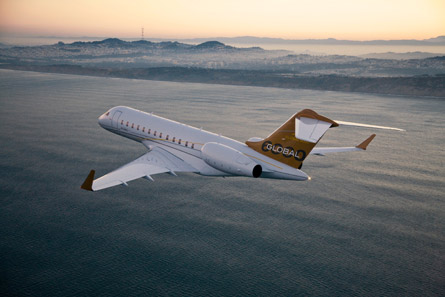 |
|---|
© Bombardier |
While the midsize jet is a key plank of the airframer's growth strategy, the Global family at the top end of the product line has been a particular focus. In contrast to its Learjet stablemates, these large-cabin types have been largely cushioned by the effects of the economic downturn because of an increase in global travel. Ridolfi admits the backlogs for these aircraft are recovering more rapidly than those in the light-jet segment. "The large-cabin Challenger jets are also holding their own with solid order pipelines," he concedes.
The rise in international travel led to the launch in 2010 of the ultra-long-range Global 7000 and 8000 jets, which are scheduled to enter service in 2016 and 2017 respectively. "We've selected and announced all major suppliers and are now actively engaged in the process for selecting additional suppliers," says Ridolfi. The in-production Global duo have not been ignored. Both the 500 and newly rebranded 6000 models now boast Bombardier's Vision Flight Deck as standard. A VIP version of the CSeries is also in the pipeline. "This is absolutely something we will integrate into our product planning portfolio when the time is right," says Ridolfi.
CESSNA
Product development is something Cessna has never shied away from. Even during this challenging economic period, the developer - with a product-line position firmly in the beleaguered lower half of the spectrum - is working on a number of new programmes.
The Citation M2 will be the first to be completed. The light business jet, which bridges the gap between the entry-level Mustang and CJ2+ light business jet, was announced six months ago and made its first flight in March.
Cessna says structural testing of the winglets is now complete and development of the aircraft's Garmin G3000 flightdeck is progressing well. The aircraft is on track for service entry in the second half of 2013. This will be followed two years later by deliveries of the first Latitude business jet. Designed to fit in Cessna's product line between the super-light Citation XLS+ and midsize Citation Sovereign, Latitude development is progressing well, Cessna says.
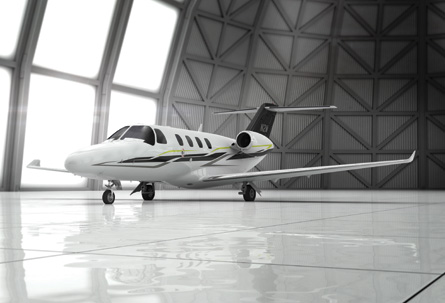 |
|---|
© Cessna The Citation M2 bridges the gap between the entry-level Mustang and CJ2+ light business jet |
Design of the nine-passenger has now been frozen and Cessna says the aircraft's projected range is now 4,255km (2,300nm), an increase of 555km. Cessna is also making progress with its Citation Ten - an enhanced version of its super-midsize Citation X with enhanced Rolls-Royce AE3007C2 turbofan engines, elliptical winglets and a new Garmin G5000 integrated avionics suite.
The aircraft made its first flight last year and is scheduled for certification and service entry in 2013. In March, Cessna announced plans to manufacture aircraft in China, where it envisages tremendous long-term potential.
"We believe in 10 to 15 years China will be one of the biggest business and general aviation markets in the world," says Cessna senior vice-president Brad Thress. "The joint venture will be for final assembly, paint, completion, flight test, and delivery of the midsize Sovereign and Latitude aircraft for the Chinese market."
Thress adds that Cessna has no plans to resurrect the large cabin Columbus, although he does not rule out offering a product in the upper end of the business jet spectrum at some stage. "Our advanced design team and market analysts have a number of new products in the development pipeline," he says.
DASSAULT
The French airframer is the only traditional manufacturer with a product positioned at the top end of the market. The high-performance Falcon family consists of the large-cabin 2000LX, long-range 900LX and ultra-long-range 7X. A year ago, Dassault shook up the comfortable super-midsize sector with the introduction of its "game-changing" 2000S that will be its new entry-level product.
The 10-passenger aircraft combines the large cabin of the 2000 with what Dassault calls "category-leading payload, range, performance and efficiency". Over 300 flight hours have been logged so far in more than 100 flights, and the aircraft is earmarked for certification later this year and service entry in 2013. The Falcon 2000S features inboard slats, high-Mach blended winglets; new generation 7,000lb (31kN) thrust Pratt & Whitney PW308C engines; a BMW DesignworksUSA interior, redesigned cockpit aesthetics and the EASy II flightdeck.
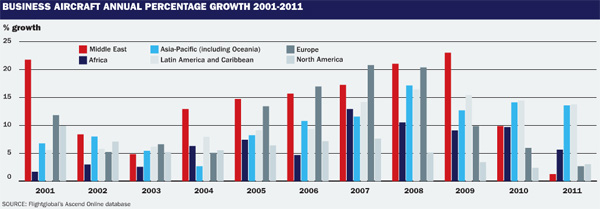
Dassault continues to keep details of its other business-jet project under wraps. It will only reveal that the clean-sheet design, dubbed the SMS business jet, will make first flight in 2014 and enter service in 2016. "We are working hard on the programme with all our partners," says Dassault Falcon president John Rosanvallon. "But we have not yet determined when we will make an official announcement to give specifications of the aircraft."
EMBRAER
Product development is at the core of Embraer's strategy. During the past six years, the airframer has launched six business jets - the Phenom 100/300, Legacy 450/500/650 and Lineage 1000 - and has made no secret of its plans to compete in all traditional business aircraft segments.
The most glaring gap in production is its long-range category. "This hole in our product line is always in our sights," says Ernie Edwards, president of Embraer Executive Jets. "Whatever we decide to do in this sector, it must be a differentiating product. Our focus for the time being is on bringing the 450 and 500 mid-range jets to market." The latter completed its first taxi tests in March and is being readied for first flight later this year. The midsize business jet is scheduled to enter service at the end of 2013, shortly after its super-light stablemate takes to the skies for the first time. Meanwhile, Embraer is only building the Legacy 600 to order because of a drop in demand for the super-midsize aircraft.

"You can pick up a Legacy 600 on the used market today, cheaper than you can make one," Edwards says. He also admits the Legacy 650 has cannibalised the 600 market: "For another $3 million you get far more range." A dedicated production line for the Legacy 600/650, with the capacity for up to 10 aircraft a year, is being set up at Embraer's factory in Harbin, China. The aircraft is destined for the Chinese market.
GULFSTREAM
China is one of the largest growth markets for Gulfstream thanks to its unquenchable appetite for large, long-range business jets. The G450, G550 and G650 are "selling well", Gulfstream says, and its latest super-midsize offering - branded the G280 to widen its appeal in the Asian market - is also selling well with the backlog now into the second quarter of 2015. The G280 is earmarked for certification late in the second quarter of 2012, with the first aircraft scheduled for delivery soon after.
The G650 backlog stretches to 2017 and many customers are electing to buy a G450 or G550 to fill the delivery gap, says Gulfstream. Certification and first deliveries of the ultra-long-range jet is expected in the third quarter.
HAWKER BEECHCRAFT
Financial woes have put a halt to new product development for this Wichita-based airframer as a result of its exposure to the shrunken and battered light business aircraft sector. The Hawker 200 - formerly the Premier II - became a casualty of the market malaise late last year when the programme was suspended. "A significant amount of investment was needed to bring this aircraft to market but we could not devote this amount of capital during such a weak market," says Shawn Vick, Hawker Beechcraft's senior vice-president.

Another of Hawker Beechcraft's light jet stable - the seven-seat Hawker 400XP - became a casualty of the financial crisis a year earlier after poor sales and low demand. Product upgrades, the company's staple diet for many years, have also dried up. The launch and service entry of a rash of upgraded products took place last year, including a winglet retrofit programme for the Hawker 750 and the King Air B200GT. The upgrade package for the twin-engined turboprops - dubbed the 200GTR - also incorporates BLR Aerospace composite winglets, a Raisbeck Engineering Ram Air Recovery System, and Hartzell four-blade composite propellers. Hawker Beechcraft also brought to market an upgrade to the midsize 800XP. This incorporates winglets and new Honeywell TFE731-50R engines. "We are continually looking to revamp our product line and there is no shortage of engineering efforts," says Vick. "However in this environment, we have to be very conservative."
PIAGGIO
This view is echoed by fellow twin-engined turboprop maker Piaggio. The Italian company has seen deliveries of its Piaggio Avanti II plummet from 36 aircraft a year in 2008 to only 14 last year, mainly because of the collapse of its strongest market. The USA is home to Piaggio's largest customer, fractional ownership provider Avantair, which has a growing fleet of 54 Avantis. The slump in US demand has forced Piaggio to explore new markets and it has courted success in China, Russia and Brazil. The launch of Piaggio's first business jet - code-named P1XX - is not expected for the foreseeable future. "When to launch the new aircraft is the decision of our shareholders [India's Tata and Abu Dhabi's Mubadala]," says Piaggio chief executive Alberto Galassi. All the key components - assembly and manufacturing locations for example - must be in place before any announcement is made."
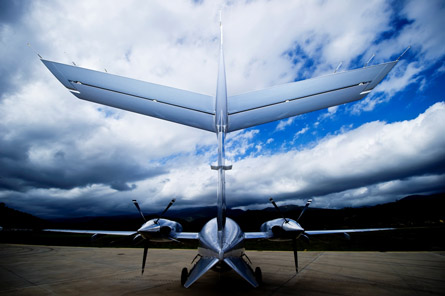 |
|---|
© Piaggio Piaggio has seen deliveries of its Avanti II plummet from 36 aircraft a year in 2008 to only 14 in 2011 |
AIRBUS/BOEING
TALKING HEADS |
"It's been another gloomy 12 months and I'm getting annoyed with it. There is always something to deal with. Firstly the financial downturn, then Barack Obama weighed with negative comments about business aviation." |
 FRANCOIS CHAZELLE FRANCOIS CHAZELLE Corporate Jets vice-president Airbus "We had higher sales of our ACJ corporate jet family last year than the year before. We expect to increase this gain in 2012. The largest market for us is China. Driven by the high number of billionaires, we expect to sell five aircraft a year there." |
 STEVE TAYLOR STEVE TAYLOR President, business jets Boeing "We are selling airplanes, but unfortunately we have had a few cancellations. Nonetheless, we are still 'net positive' which is better than some competitive manufacturers. I remain optimistic that the market will strengthen." |
"Business aviation has never been more exciting. Our industry has just gone through a decade that has changed the landscape. The driving forces are redefining the market in which we do business. |
"The global business jet market remains challenging but we see slight improvements in 2012. Order and inquiry activity remained very positive in the first quarter of 2012, stronger than the last three years." |
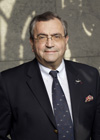 JEAN ROSANVALLON JEAN ROSANVALLON Falcon president Dassault "We were back on a positive footing last year. Although we had to clean up our backlog we ended up with net orders for 36 Falcon business jets. China became the number-one market for us." |
"The first quarter of the year has been slow, but that followed a flurry of activity at the end of last year when we emptied our hopper. Overall, there is an air of cautious optimism. I've not used that word for a long time. The market is showing signs of recovery." |
"The midsize cabin sector [the G150] has been slow so we have had to adjust production to meet market demand. This is in contrast to the large-cabin jet market which is really bullish. Production has been unaffected." |
"The debt on the balance sheet is not reflective of the market so we are having to address this. We have a great brand and a great business so I am confident we will come through the other side." |
INDEPENDENT PROGRESS
For the independent developers, the outlook is bullish. Honda Aircraft is making huge strides with its HondaJet programme. The first aircraft, which began flight testing last year, will be joined in the coming weeks by two additional models leading to certification of the advanced light business jet next year. The approval will come one year later than originally planned because of a required redesign of the aircraft's GE Honda HF120 engine.
US certification of the 1,950lb thrust take-off engine is scheduled for later this year. Meanwhile, very light jet developer Eclipse Aerospace has US production certification, paving the way for the Albuquerque, New Mexico-based manufacturer to begin full-scale production of the seven-seat Eclipse 550. The $2.7 million aircraft is an updated version of the E500, featuring synthetic vision and autothrottles. Service entry is set for the third quarter of 2013.
PERSEVERANCE PAYS OFF FOR PERSONAL JETS
It has been a year of mixed fortunes for developers of single-engined personal jets. Piper withdrew its Altaire from the race last October, blaming rising development costs and a bleak market outlook. But the pessimism is not shared by personal-jet pioneers Cirrus and Diamond, which have both secured substantial investment in the past 12 months to bring their products to market in the next three years.
Diamond hopes its five-seat, $1.9 million D-Jet will be first across the finishing line in 2014 – a year earlier than Cirrus’s Vision SF50. This is a drastic turnaround for the London, Ontario-based company, which was forced only months earlier to suspend development of the Williams International FJ33-5A-powered aircraft after the Canadian government denied a C$35 million ($36 million) loan that was to be matched by the provincial government. The latest round of funding from an undisclosed source paved the way for flight testing to resume. The D-Jet has a maximum cruise speed of 315kt (580km/h) and a maximum range of 2,500km (1,350nm).
NEW OWNER
Cirrus’s SF50 non-conforming prototype has been flown for 600h and the manufacturer’s new owner – China Aviation Industry General Aircraft (CAIGA) – has pledged $100 million to bring the seven-seat aircraft to market in 2015. The Duluth, Minnesota-based airframer has already invested more than $45 million in the SF50, which made its first flight in July 2008 and has chalked up a sizeable order tally of 500 aircraft. The SF50 has a cruise speed of 300kt and a range of 1,850km. The aircraft is priced at $1.72 million until 30 June, when it will rise to $1.96 million.
Meanwhile, Stratos Aircraft is making headway with its $2 million personal jet, dubbed the S714. The newcomer last year completed windtunnel testing of a 1/5th scale model of its Williams FJ44-3AP-powered aircraft and has closed on additional outside funding which will allow it kick-start tooling manufacturing. Stratos says the aircraft’s development schedule is “funding dependent”, but it is “increasingly optimistic about the investment picture”.
SINGLE-ENGINED TURBOPROPS BACK FROM THE BRINK
Protracted economic downturn continues to fluster the makers of single-engined turboprops, sales of which have declined. But these niche products have been shielded from a worse fate by their versatility and low operating costs.
"Some customers who would have shopped for a business jet at the height of the market are now choosing turboprops as the cost of operation is so much lower, says Philippe de Segovia, director of product marketing for Daher Socata, developer of the TBM 850.
"We have seen our annual deliveries fall from a height of 60 units in 2008 to 38 aircraft last year. However, the market is starting to climb again, albeit slowly," he adds. "We have to come up with fresh ideas and innovations to retain customer interest in the product and stimulate new business."
LATEST INCARNATION
In March, Daher unveiled the latest incarnation of the high-speed turboprop: the Elite. In this design, middle seats can be forward-facing and rear seats removed - boosting luggage capacity from 13ft3 (0.37m3) to 30ft3. The seven-seat TBM 850 Elite offers two new avionics options: a long-range KHF 1050 HF radio and Garmin's GSR 56 Iridium satellite transceiver. Deliveries of the $3.2 million aircraft are to begin in the third quarter.
Quest Aircraft, meanwhile, has started delivering its Kodiak turboprop single with an enhanced Garmin G1000 avionics suite. Improvements - certificated in February - include a remote terrain awareness warning system inhibit switch, and an air-conditioning inhibit functionality, which prevents use of the air-conditioning system during certain engine and generator power situation. The Sandpoint, Idaho-based manufacturer is seeking to boost production of the $1.75 million, high-wing aircraft from 16 in 2011 to 30 this year. The 10-seat aircraft has been certificated in Brazil and Mexico this year. Quest also plans to offer a forward-fit "summit" club-configured interior and an airborne surveillance variant.
DIFFICULT CONDITIONS
Switzerland's Pilatus Aircraft has no upgrades planned for its PC-12NG. One of Europe's last remaining privately owned airframers, Pilatus delivered 63 aircraft in 2011, down from 100 in 2009. "The PC-12 is the most successful turboprop," it says. Executive configurations account for about 75% of PC-12NG sales, with the bulk of demand from North America. "Our annual deliveries for 2011 still represent a good sales effort given the very difficult market situation in the field of general aviation," says Pilatus.
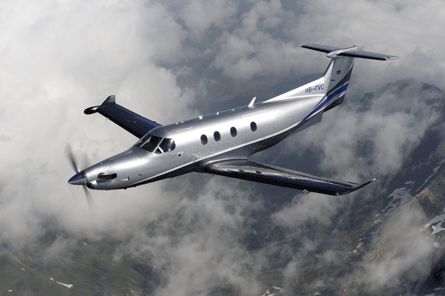 |
|---|
© Pilatus Pilatus delivered 63 aircraft last year |
Demand has "held up" for Cessna's 12-passenger Caravan, says Jodi Noah, senior vice-president of single-engined aircraft. "Because so much of the Caravan customer base is commuter airlines and other commercial operators, the aircraft are a critical part of their business and generating revenue for them," she adds. A small increase in sales is expected this year, thanks to demand from China, southeast Asia, Russia and "even the US market". Caravan deliveries were 93 last year, compared with 95 in 2010, GAMA figures reveal.
Piper Aircraft says sales of its seven-seat Meridian single have been "spurred by higher European demand for fuel-efficient business aircraft". Enrico Evers, Piper directors of sales for Europe, Middle East and Africa, says three seven-seat Meridians have already been delivered this year with about five more scheduled for "European retail customers". Last year, 32 Meridians were delivered, up from 25 the year before, GAMA records.
Newcomer Kestrel plans to break ground in the third quarter on a composite manufacturing facility in Superior, Wisconsin for its eight-seat turboprop single. A dedicated production plant for the Honeywell TPE331-14GR-powered aircraft will be built in 2013. The configuration of the British-designed Kestrel - formerly known as the Farnborough F-1 - is almost frozen, with certification earmarked for 2015.
- Keep in touch with all the news from EBACE via our dedicated landing page
Source: Flight International

















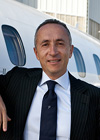 ALBERTO GALASSI
ALBERTO GALASSI STEVE RIDOLFI
STEVE RIDOLFI BRAD THRESS
BRAD THRESS ERNIE EDWARDS
ERNIE EDWARDS LARRY FLYNN
LARRY FLYNN SHAWN VICK
SHAWN VICK

